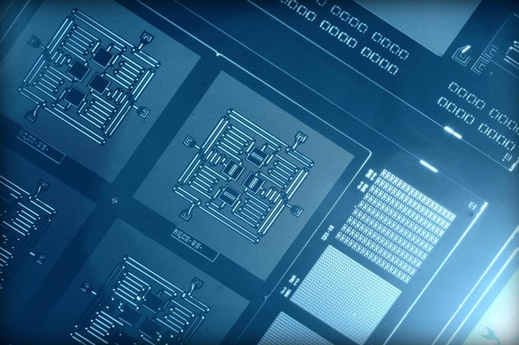IBM Shows Off a Quantum Computing Chip
A superconducting chip developed at IBM demonstrates an important step needed for the creation of computer processors that crunch numbers by exploiting the weirdness of quantum physics. If successfully developed, quantum computers could effectively take shortcuts through many calculations that are difficult for today’s computers.

IBM’s new chip is the first to integrate the basic devices needed to build a quantum computer, known as qubits, into a 2-D grid. Researchers think one of the best routes to making a practical quantum computer would involve creating grids of hundreds or thousands of qubits working together. The circuits of IBM’s chip are made from metals that become superconducting when cooled to extremely low temperatures. The chip operates at only a fraction of a degree above absolute zero.
IBM’s chip contains only the simplest grid possible, four qubits in a two-by-two array. But previously researchers had only shown they could operate qubits together when arranged in a line. Unlike conventional binary bits, a qubit can enter a “superposition state” where it is effectively both 0 and 1 at the same time. When qubits in this state work together, they can cut through complex calculations in ways impossible for conventional hardware. Google, NASA, Microsoft, IBM, and the U.S. government are all working on the technology.
There are different ways to make qubits, with superconducting circuits like those used by IBM and Google being one of the most promising. However, all qubits suffer from the fact that the quantum effects they use to represent data are very susceptible to interference. Much current work is focused on showing that small groups of qubits can detect when errors have occurred so they can be worked around or corrected.
Earlier this year, researchers at the University of California, Santa Barbara, and Google announced that they had made a chip with nine superconducting qubits arranged in a line (“Google Researchers Make Quantum Computing Components More Reliable”). Some of the qubits in that system could detect when their fellow devices suffered a type of error called a bit-flip, where a qubit representing a 0 changes to a 1 or vice versa.
However, qubits also suffer from a second kind of error known as a phase flip, where a qubit’s superposition state becomes distorted. Qubits can only detect that in other qubits if they are working together in a 2-D array, says Jay Gambetta, who leads IBM’s quantum computing research group at its T.J. Watson research center in Yorktown Heights, New York.
A paper published today details how IBM’s chip with four qubits arranged in a square can detect both bit and phase flips. One pair of qubits is checked for errors by the other pair of qubits. One of the pair doing the checking looks for bit flips and the other for phase flips.
“This is a stepping stone toward demonstrating a larger square,” says Gambetta. “There will be other challenges that emerge as the square gets bigger, but it looks very optimistic for the next few steps.”
Gambetta says his team had to carefully design its new chip to overcome interference problems caused by putting the four qubits so close together. They are already experimenting with a chip that has a grid of eight qubits in a two-by-four rectangle, he says.
Raymond Laflamme, director of the institute for quantum computing at the University of Waterloo, Canada, describes IBM’s results as “an important milestone [toward] reliable quantum processors.” Tackling errors is one of the field’s most important problems. “Quantum computing promises to have many mind-boggling applications, but it is hindered by the fragility of quantum information.”
Truly solving that problem requires going one step further than IBM’s latest results, and correcting qubit errors as well as detecting them. That can only be demonstrated on a larger grid of qubits, says Laflamme. However, not all quantum computing researchers think that qubits like those being built at IBM, Google, and elsewhere will ever be workable in large collections. Researchers at Microsoft and Bell Labs are working to create a completely different design of qubit that should be less prone to errors in the first place (see “Microsoft’s Quantum Mechanics”).
Keep Reading
Most Popular
Large language models can do jaw-dropping things. But nobody knows exactly why.
And that's a problem. Figuring it out is one of the biggest scientific puzzles of our time and a crucial step towards controlling more powerful future models.
How scientists traced a mysterious covid case back to six toilets
When wastewater surveillance turns into a hunt for a single infected individual, the ethics get tricky.
The problem with plug-in hybrids? Their drivers.
Plug-in hybrids are often sold as a transition to EVs, but new data from Europe shows we’re still underestimating the emissions they produce.
Stay connected
Get the latest updates from
MIT Technology Review
Discover special offers, top stories, upcoming events, and more.